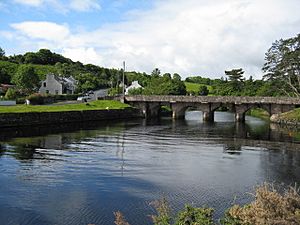River Dun (Northern Ireland) facts for kids
The River Dun, also called the Glendun River, flows through County Antrim in Northern Ireland. Its name in Irish, Abhann Duinne, means "brown river." This brown color comes from the peat bogs where the river starts. These bogs are high up on the slopes of Slievenanee.
The River Dun runs through Glendun, which is one of the nine famous Glens of Antrim. Its source is close to the start of the River Bush. The River Bush flows north-east to the sea near Bushmills. At the mouth of the River Dun, you'll find Cushendun. This is a small coastal town that sits right where the river meets the sea.
The Amazing Glendun Viaduct
A large bridge called the Glendun Viaduct crosses the River Dun. This impressive bridge has three arches. Charles Lanyon finished building it in 1839. People living nearby often call it the "Big Bridge."
Work on the viaduct happened between 1834 and 1839. Builders did not work during the cold winter months. The stones used for the bridge came from a place called Layde. They were brought by boat to Cushendun. From there, carts carried the heavy stones to the bridge site.
Fish Life in the River Dun
The River Dun is home to different kinds of fish. You can find brown trout here. These trout usually weigh less than one pound. This is because the river water is naturally a bit acidic.
From July onwards, sea trout and salmon swim into the river. They travel upstream to special areas where they lay their eggs. This process is called spawning. You can also find eels living in the River Dun.


